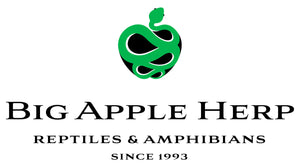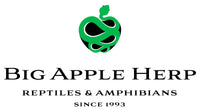Care Sheet For Crested Geckos
Crested Geckos have become increasingly popular as pets over the last few years for a number of good reasons: they are absolutely cute, have individual personalities, are easy to handle and do not require extensive care requirements or enclosures. Additionally, they are relatively easy to breed. At Big Apple Pet Supply, all of our Crested Geckos are captive bred and we maintain a strict quality control.
Housing
One or two adult Crested Geckos can be set up in an enclosure as small as a 20 gallon (30" x 12" x 13"H) but a larger enclosure of 30 to 40 gallons (36" x 18" x 13"H) would allow for additional room and a better design. A secured screen top is a must since Cresteds can climb glass - in fact, they often hang out on the sides of their enclosure. Crested like to have logs, plants (faux or live), rocks and/or vines for hiding and basking.
You may house several similar size female Crested Geckos together but even multiple females will compete for food so make sure any smaller geckos are receiving their share of the food, heat, etc. We do not recommend housing more than one male in an enclosure as males are territorial and typically will fight. One male and several females can generally be housed together but we recommend this for more seasoned reptile enthusiasts as there are multiple issues that can arise causing stress, shortened lifespan, etc. Regardless of sex, you should consider separating any vastly smaller or larger animals.
Substrate
Most people use a combination of substrates including coconut fiber, such as Zoo Med Eco Earth; cypress mulch, such as Zoo Med Forest Floor; and Big Apple's Imported Premium Grade Sphagnum Moss.
Heating
As with all reptiles, Crested Geckos need a thermal gradient consisting of a warm side of 78° Fahrenheit and a cool side of 68° F. The best way to heat your gecko enclosure is with a low wattage ceramic heat emitter. We recommend the Big Apple Black Heat Infrared Ceramic Heat Emitter. The heat emitter should be on one side while the other side should not have any heat source. We recommend controlling the ceramic emitter with a thermostat, such as the BAH-500 or BAH-1000DC, and monitoring the temperatures with a thermometer.
Lighting
Crested Geckos are generally not active during the day and do not need a light or UV bulb. They often remain in a dark hiding place during the day so adding lights to a Crested Gecko cage is not advisable since it can stress them out and actually cause health issues.
Shelter
Crested Geckos do not need a specific hiding place per se but they do need decor items that they can climb such as bendable vines, cork bark, driftwood or bamboo tubes. If you choose to make your own climbing and perching decor please make sure that it is sturdy enough that there is no potential for collapsing and crushing your gecko.
Shedding
Like all reptiles and amphibians, Cresteds shed their entire skin all at once. Babies shed more often than adults because as babies they outgrow their skin faster. It is not unusual to see Cresteds eat their entire skin during the process of shedding since it contains valuable nutritional components. Geckos can normally pull their shed off easily but sometimes they have issues if they do not have the proper humidity while shedding. You need to check your gecko after it has shed to make sure it was able to peel all the skin off, especially from their toes. If shed skin is not removed promptly from the toe, the toe can become cut off from its blood supply and in time the toe can die and actually fall off. Your gecko is equipped with all its toes for a reason and while it is not usually critical to the gecko’s health to have all their toes, it is and easily preventable issue.
Providing moist bedding will enable your gecko to have a high humidity location when it is shedding. Use moistened Big Apple Imported Premium Grade Sphagnum Moss or Zoo Med Forest Floor Bedding. If your gecko has retained skin after shedding you can place the gecko in a small plastic container lined with warm, wet paper towels. With the top of the container on, let the gecko sit for approximately 30 minutes. The high humidity in the container should loosen the skin enough to allow you to remove it easily with a pair of tweezers. If the skin has not loosened enough reheat the paper towels with warm water and provide another 30 minute session. NEVER use hot water as this can burn your gecko’s sensitive skin.
Water
Crested Geckos should have a water bowl in their cage but their cage should be misted twice a day as they will happily lick water off leaves, branches, etc. As for a water bowl, place the water dish on the cool side of the cage so that it does not evaporate quickly and make sure that your bowl is deep and big enough that your gecko can get into it but not so deep that it can potentially drown.
Food
Crested Geckos are hardy eaters and eat a variety of fruits, nectars and insects. Fruits should include sweet pulp fruits, such as apricot, peach, mango, nectarine, passionfruit, apricot or pear. Serve as a puree or finely chopped. Insects are also part of the diet, such as crickets, grasshoppers, silkworms and occasionally waxworms. A crested gecko's jaw is not particularly strong so hard-bodied live food like mealworms may not be the ideal food. It is important to select the proper prey size. The general rule for selecting the proper size of crickets is the cricket should be no longer than the length of the gecko's head. For baby geckos this usually means 3/8" or smaller crickets and for juvenile geckos 1/2" crickets and adult geckos can handle 3/4" crickets. We recommend that you feed only as many insects as your gecko can eat in 10 to 15 minutes.
Vitamins
It is important to feed high quality food to your prey items, called "gut loading". The food that is in the prey item's belly is the food that your reptile will be eating. Zoo Med All-Natural Cricket Care offers complete gut load for you your crickets. In addition, you should coat your crickets and mealworms with vitamin and calcium powders, such as such as Zoo Med Repti Calcium with D3 or Rep-Cal Calcium, before feeding them to your reptile.
Cage Maintenance
Crested Geckos require minimal maintenance but cleaning of feces and urine areas should be taken care of 3 to 4 times a week. The bedding should be completely thrown out and the entire cage (including all accessories) should be washed with Quat TB Pet Area Cleaner, Deodorizer & Stain Remover or a mild detergent at least once every four to five months. If using paper towels, change all paper towels at least once a week.
Hibernation
Hibernation while being natural for Crested Geckos in the wild is not necessary for pet geckos. We believe you should heat your Crested Geckos throughout the winter so that they continue to eat, drink and be active. A general reduction in feeding behavior is normal during winter months due to temperature fluctuations in your house. As long as they keep fairly consistent weight it is generally not an issue and normal feeding typically resumes in the spring.

